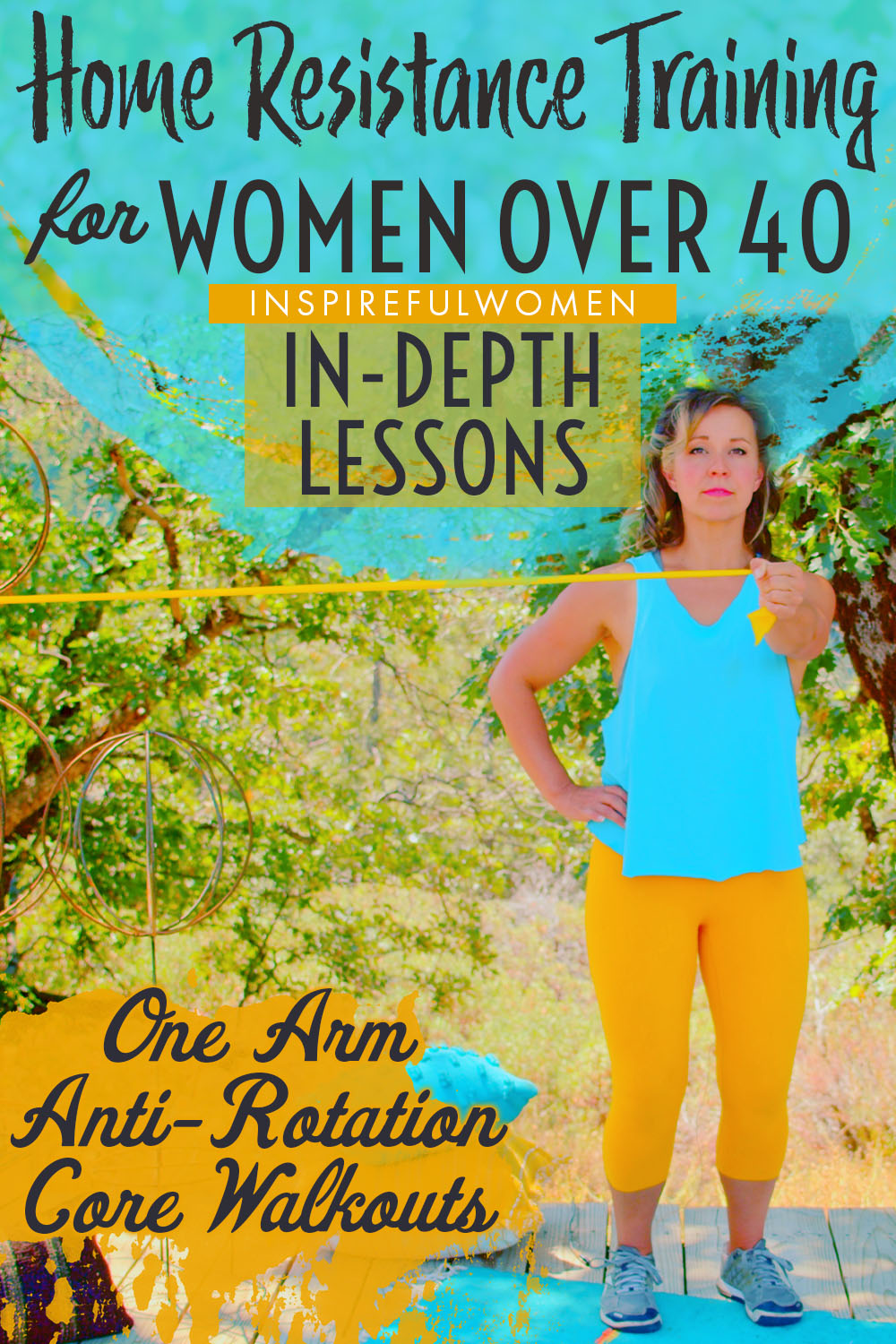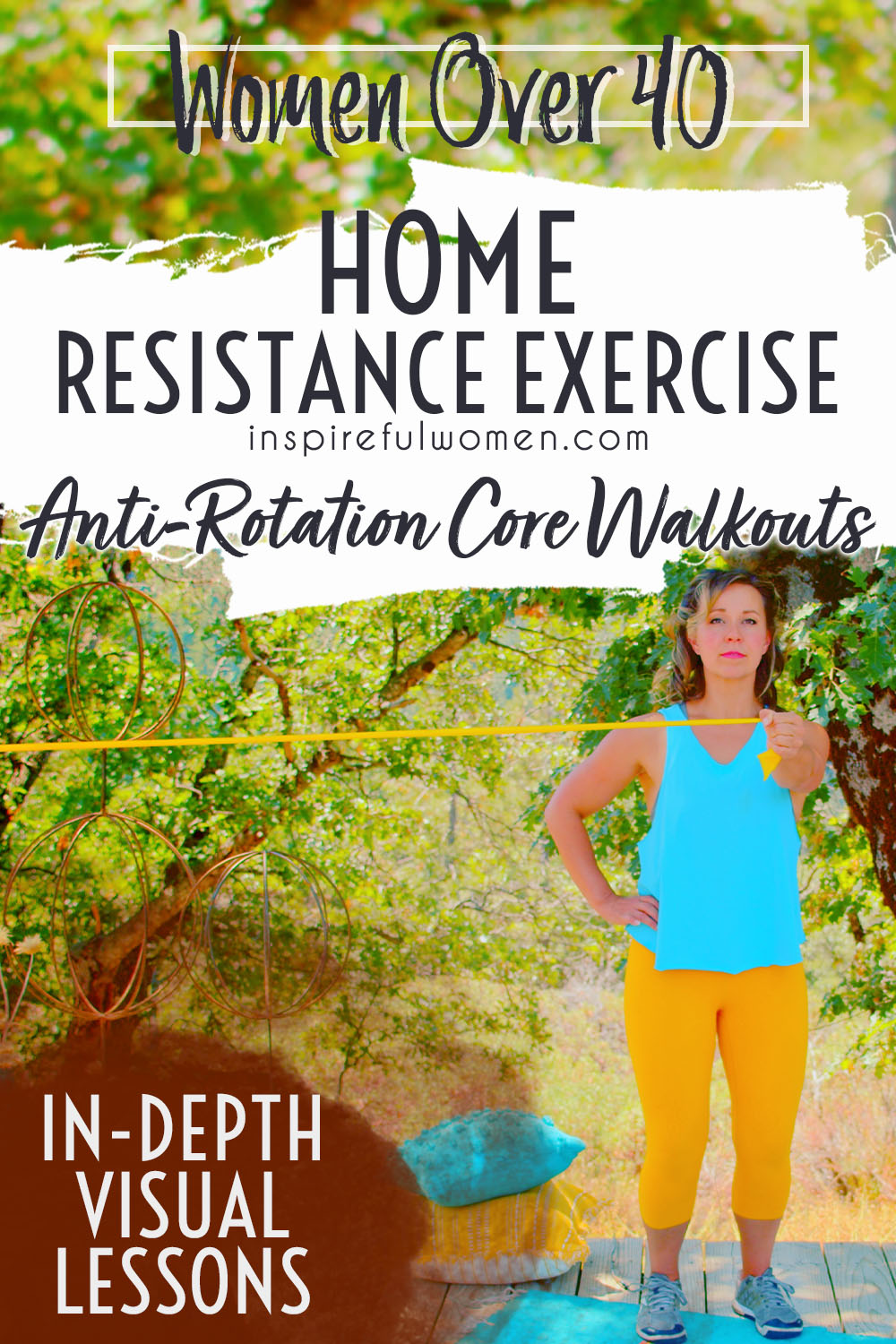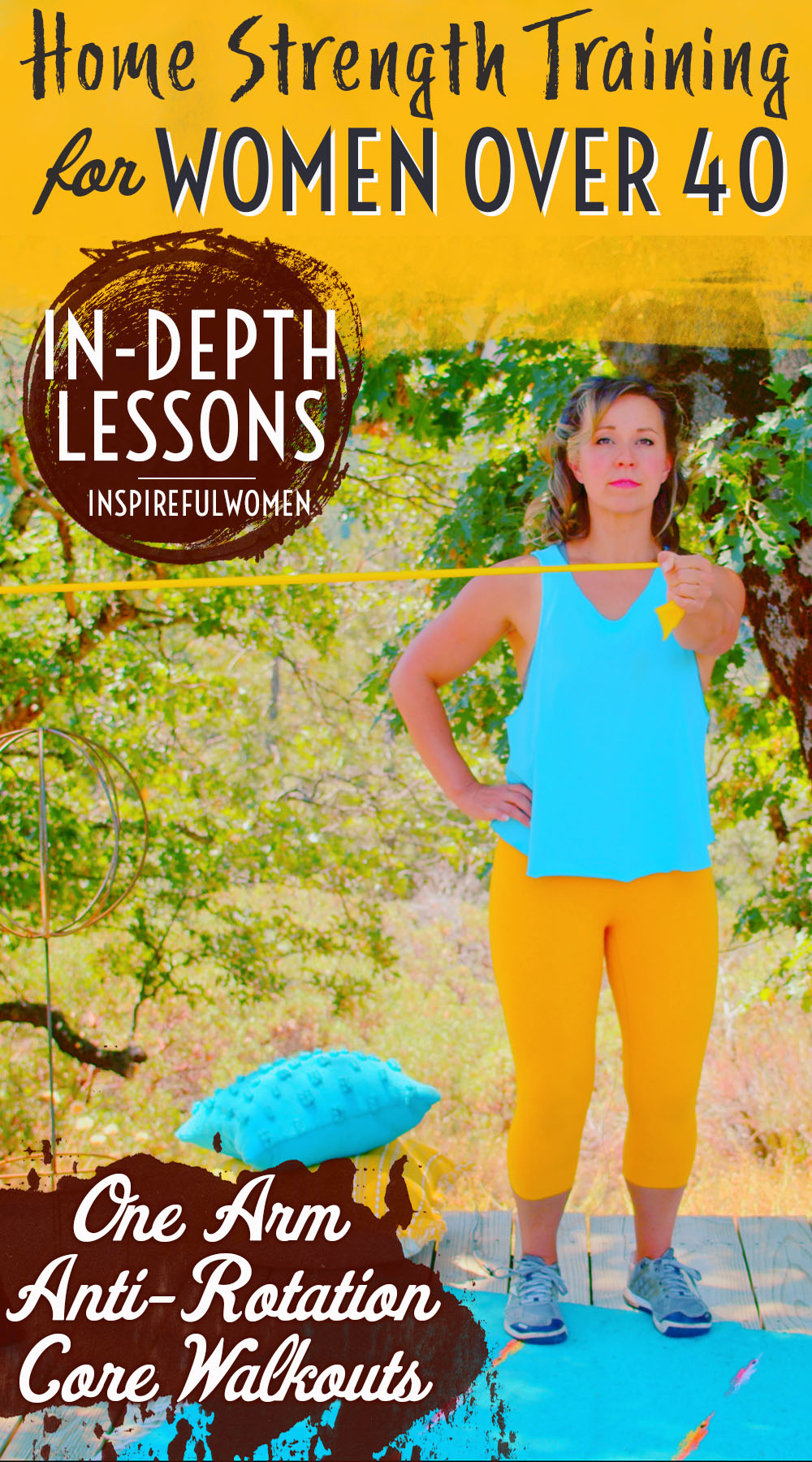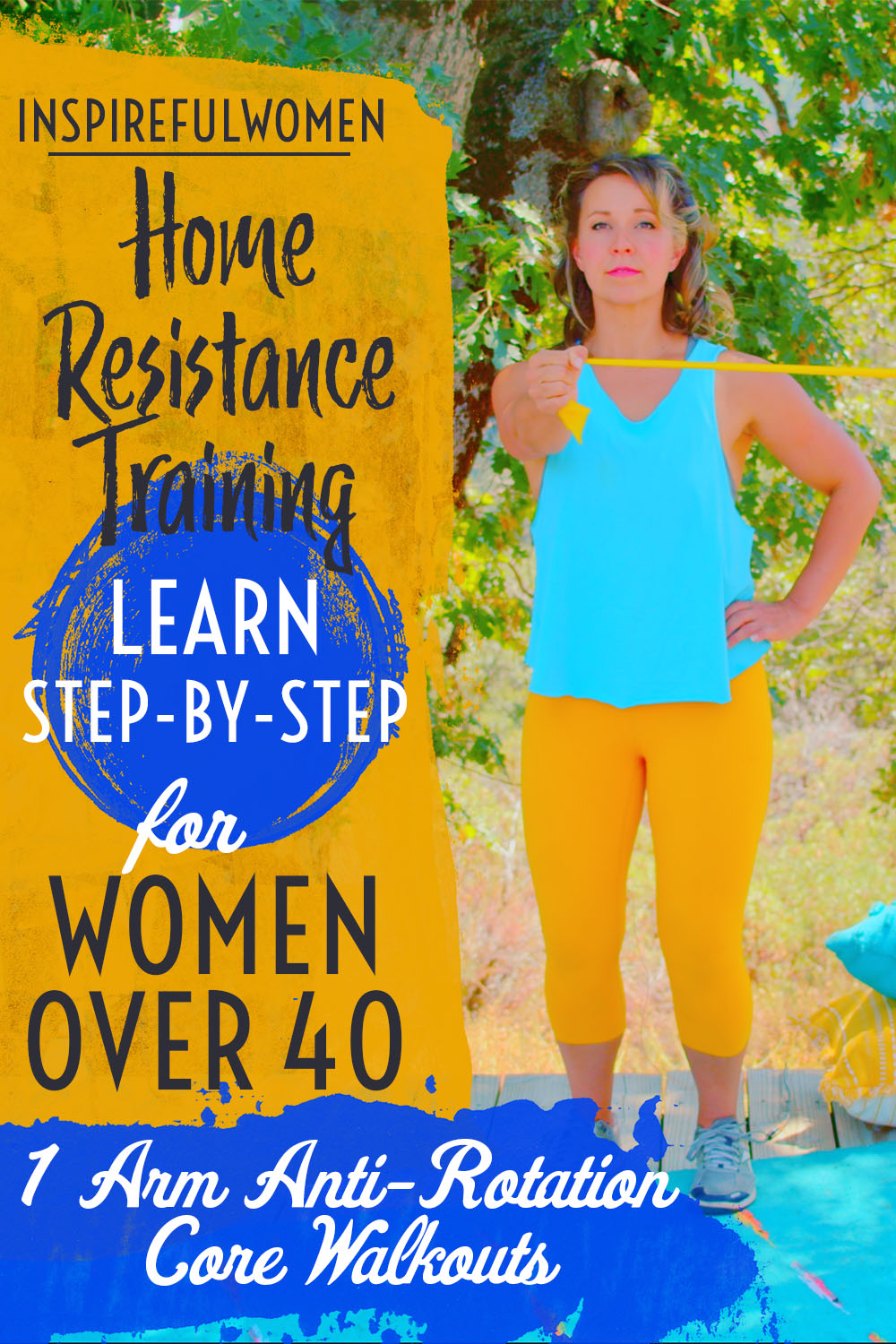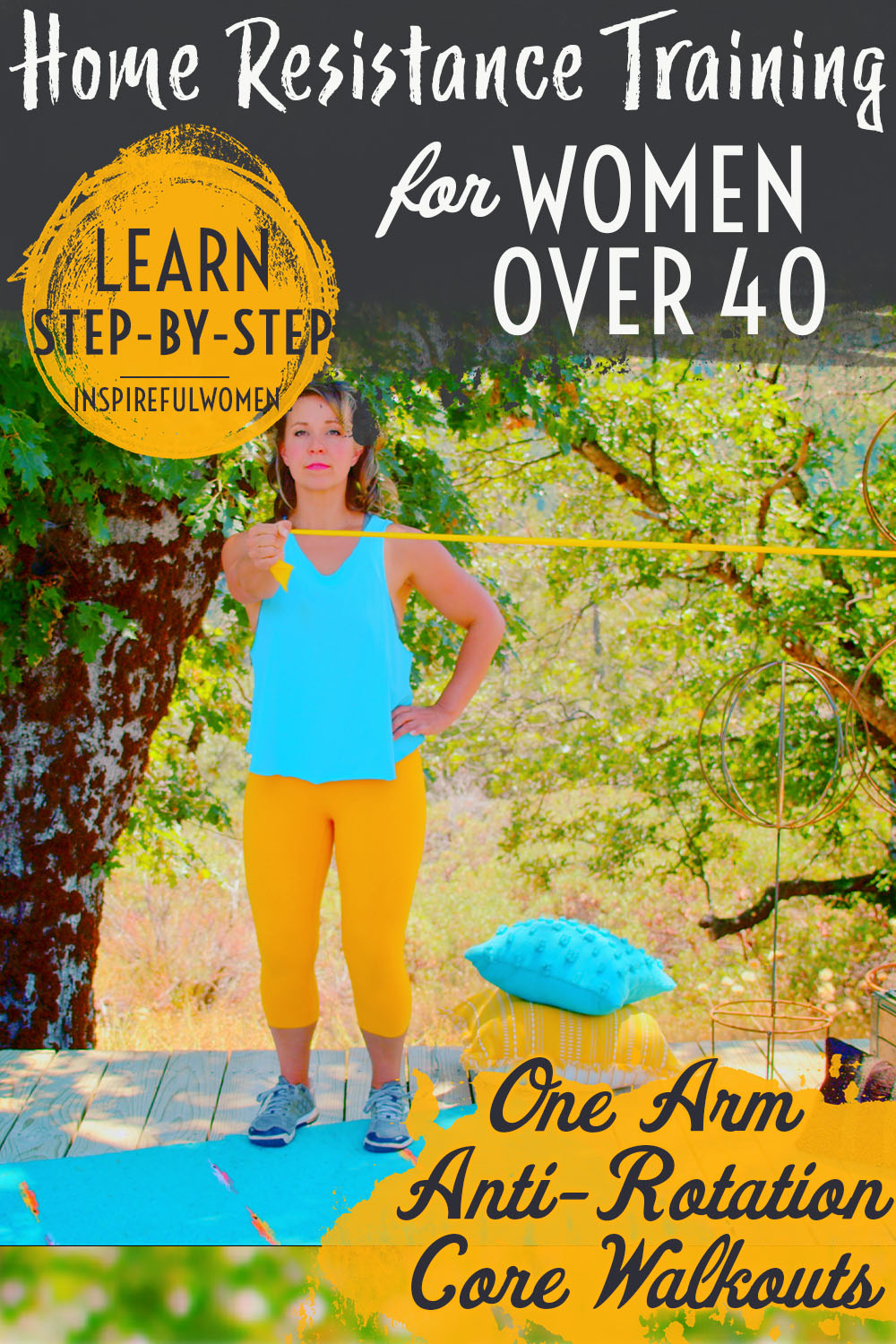1-Hand Anti-Rotation Core Walkouts
How to Do the Single Hand Anti-Rotation Walkout - Easy Standing Core Exercise | In-Depth Guide [VISUAL LEARNERS] Beginner
Proper Form & Common Mistakes | Home Resistance Training
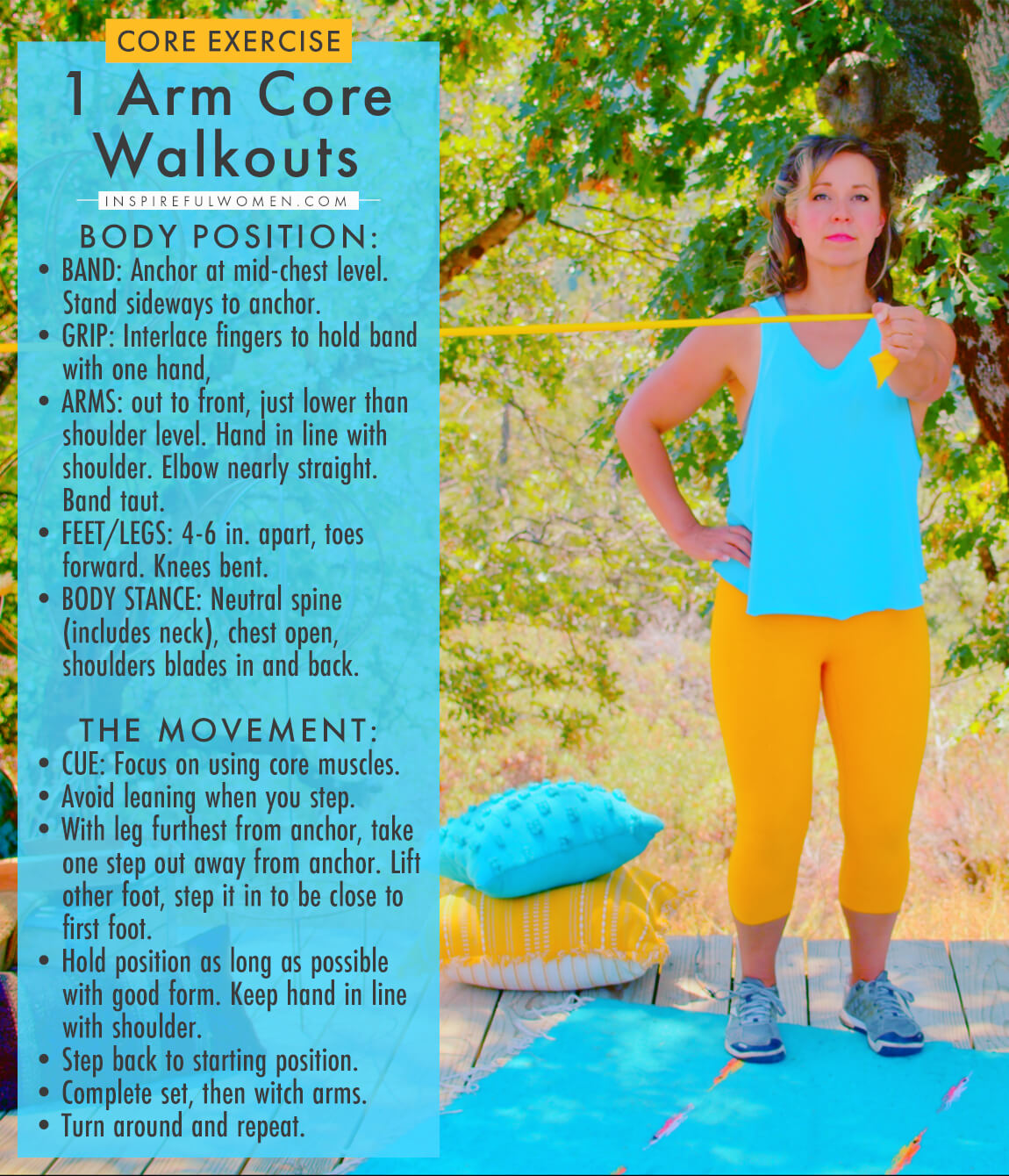
WHAT DO YOU WANT TO SEE?
QUICK DEMO
QUICK DEMO
MUSCLES THIS WORKS
MUSCLES
MAIN MUSCLES WORKED IN One Hand Anti-Rotation Walkouts
OBLIQUES
OTHER MUSCLES WORKED:
- Quadratus lumborum
- Gluteus medius and minimis
- Transverse Abdominis
STARTING POINTERS
Starting Pointers
WHAT WE'RE DOING TODAY
Other names for this exercise: 1 Arm Anti-Rotation Step Outs
For this version of the Anti-Rotation Walkouts, hold the band with only one hand instead of two. This is a good option for identifying differences in left and right strength of the core and shoulders. It is interesting how using just one hand feels so different. This is because the working arm will need to hold against the pull of the band without assistance from the other arm. When you use two hands to hold the band, the arm closest to the anchor pushes in and the arm furthest from the anchor is pulling out. The arms are working together. Using just one armworks the arm muscles more but will also challenge the core muscles more. This version requires much more control to try to keep the arm centered at mid-chest. To work both sides equally, do just the left arm and just the right arm facing the same direction then turn around and do the arms individually on that side.
HOW TO DO THE EXERCISE
LOOKS
HOW One Hand Anti-Rotation Walkouts SHAPE OUR BODY
Tones waist and flatter abdomen.
PROPER FORM
PROPER FORM: One Hand Anti-Rotation Walkouts
EQUIPMENT, SETS & REPS
EQUIPMENT
Main set (3: Light/Med/Heavy)
X-Heavy Band (I recommend getting this too if you plan to use resistance bands frequently).
SUGGESTED STARTING WEIGHT FOR WOMEN:
Lightweight resistance bands
SETS & REPS:
Walkout as far as you are able to maintain good alignment 5 - 8 times on each side.
PACE:
Slow and controlled.
BODY POSITION
BODY POSITION FOR THE One Hand Anti-Rotation Walkout
BAND: Mount the resistance band at mid-chest height - in a straight line from your hands when your arms are in the starting position. Stand sideways to the band.
HANDS: Hold the other end of the band in one hand - it doesn’t matter which one, you will be the other arm after completing the reps with your first arm.
ARMS: Hold your working arm out straight (in line with the shoulder joint), not quite to shoulder level (about 70 degrees of flexion), elbow nearly straight but can have a slight bend. The position of your arm is dependent on your strength and control. The straighter the arm (the hand further away from the body increases the lever arm) the greater the resistance. Keep in mind that the rotational force is dependent on how far your hand is in front of your body. If you use a heavy band but move your hand in and closer to your body then your obliques will not need to work as hard, but your legs will work harder. To target your core use a lighter band with your hand out as far as possible. Step forward or backward as needed until the band is in a straight line with your hand in this starting position. The hand of your non-working arm can be on the top of your pelvis to monitor the position or hanging down by your side.
FEET: Feet about 4-6 inches apart, toes pointed forward.
BODY STANCE: Knees bent (mini squat), engage your abdominals, neutral spine (includes cervical spine), sternum lifted, bring your shoulder blades in and down your back, chest wide to begin. Stacked - shoulders over hips over feet. Pelvis level, hips and shoulders squared.
HOW TO DO
HOW TO DO One Hand Anti-Rotation Walkouts
CUE: Focus on keeping your hand in one place. Keep your hips squared and your pelvis level, no leaning. It is helpful to do this in front of a mirror.
Pick up your leg furthest from the anchor and take a small side step out away from the anchor. All of the movement should come from your hip abducting to take your leg straight out to the side. Lift your foot closest to the anchor and move it over to be beside your other foot.
Continue side stepping out as far as you are able to maintain alignment: stacked - shoulders over hips over feet, pelvis, hips and shoulders squared and level - without leaning your body when you walk. You should be able to draw a straight line from the front down the middle of your head and torso; and from the side: earlobe-shoulder-hip-knee and ankle at all times during the exercise.
Keep your toes pointed straight forward or even toe in a little bit, avoid letting your legs rotate so that your toes are pointing out. You may find that in the beginning, you are only able to take one or two steps out.
Once you have reached your limit, side-step back to the starting position with good control. It is harder to walk back in because the band is pulling you (eccentric muscle activity).
Repeat for a set number of reps switch arms and repeat.
Turn around and repeat with the reps with your left and right arms.
HOW TO SAFELY GET OUT OF THE EXERCISE
From the beginning position, release the band.
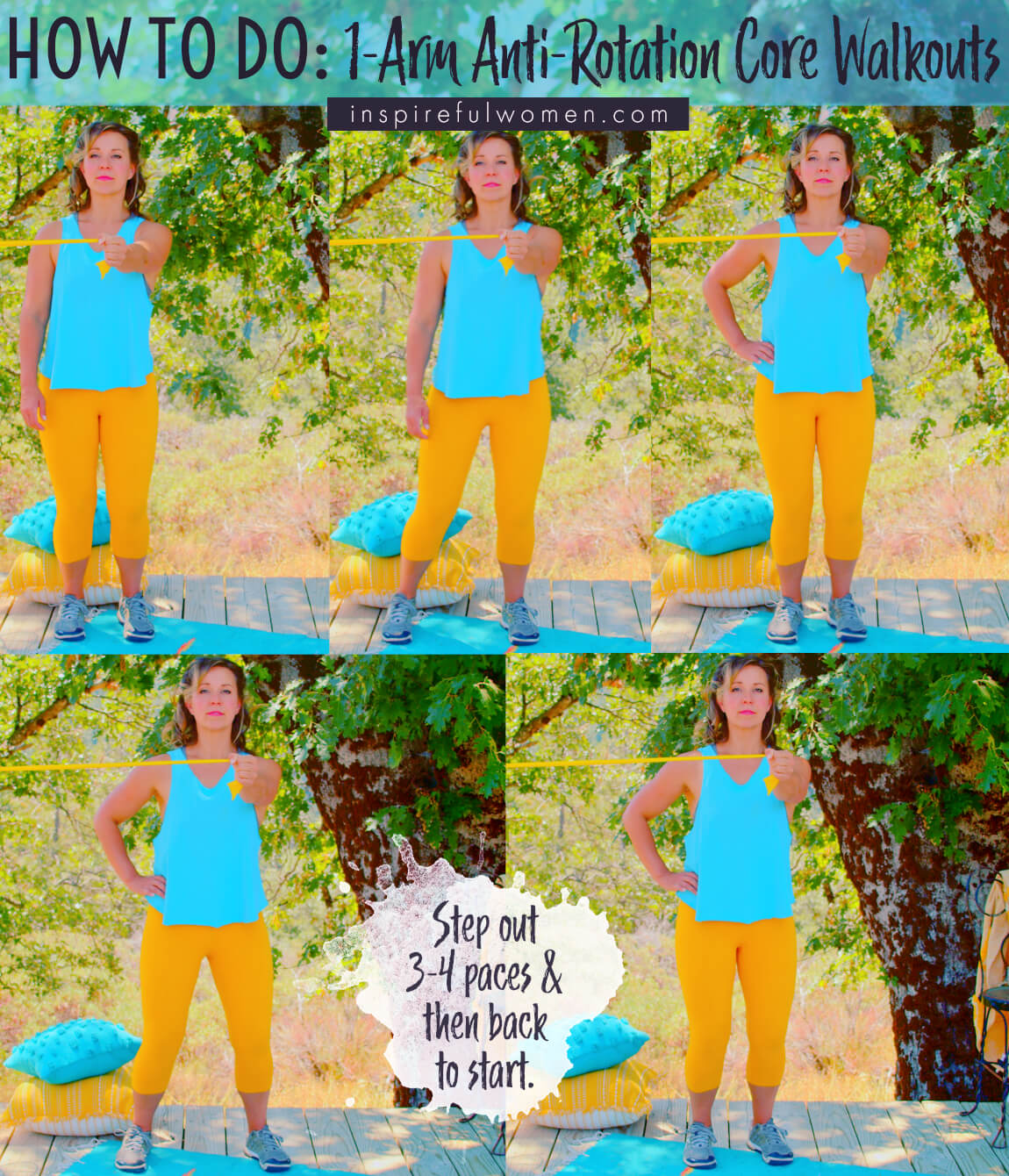
COMMON MISTAKES
COMMON MISTAKES
WHAT TO AVOID WITH THE One Hand Anti-Rotation Walkout
KEY TIP:
Guess what? Good news! Many avoids are the same for most movements. Once you learn the basics, there's really only a few extra avoids for each individual movement.
1. Avoid Leaning The Body When You Step Out To The Side
AVOID: Avoid leaning the body when you step out to the side.
WHY NOT?
- It is common to lean over towards the band anchor as you lift the leg furthest from the anchor to step out.
- This decreases muscle activity and uses gravity to help with the movement.
WHAT TO DO:
- Keep the knees bent and the motion isolated to the hip joint.
- The shoulders and pelvis should be level throughout the exercise.
- Imagine a book balanced on your head.
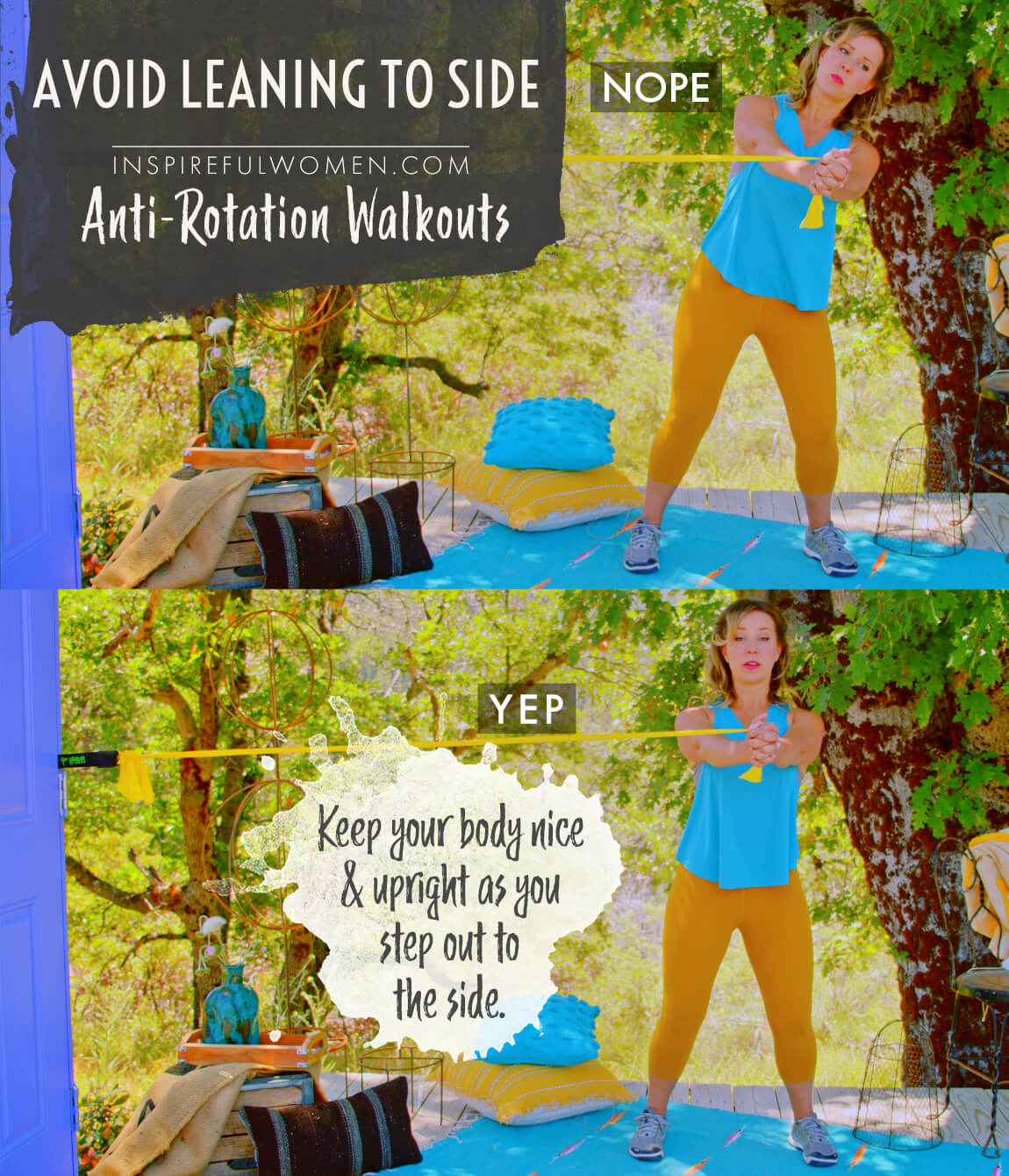
2. Avoid letting your shoulders rotate
AVOID: Avoid letting your shoulders rotate.
WHY NOT?
- This is a challenging exercise and it is easy to let the hands move towards the anchor.
WHAT TO DO:
- Keep focused on keeping the hands at the midline of the chest.
- Using a mirror helps to keep your form
- Avoid using too much resistance or stepping out too far.
- If you need to bend the elbows a little bit, this will decrease the rotational force
- Make sure that you have tried a lighter resistance band first.

3. Avoid toeing out
AVOID: Avoid toeing out. Keep the toes of both feet pointed forward.
WHY NOT?
- This is a common cheat that happens without you even realizing it - be mindful.
- The quadriceps are much stronger than the gluteus medius and minimis, rotating the thigh out is an attempt to use the stronger quads
WHAT TO DO:
- Keep the toes of both feet facing forward or even toe in a bit to make sure you are using the gluteals.
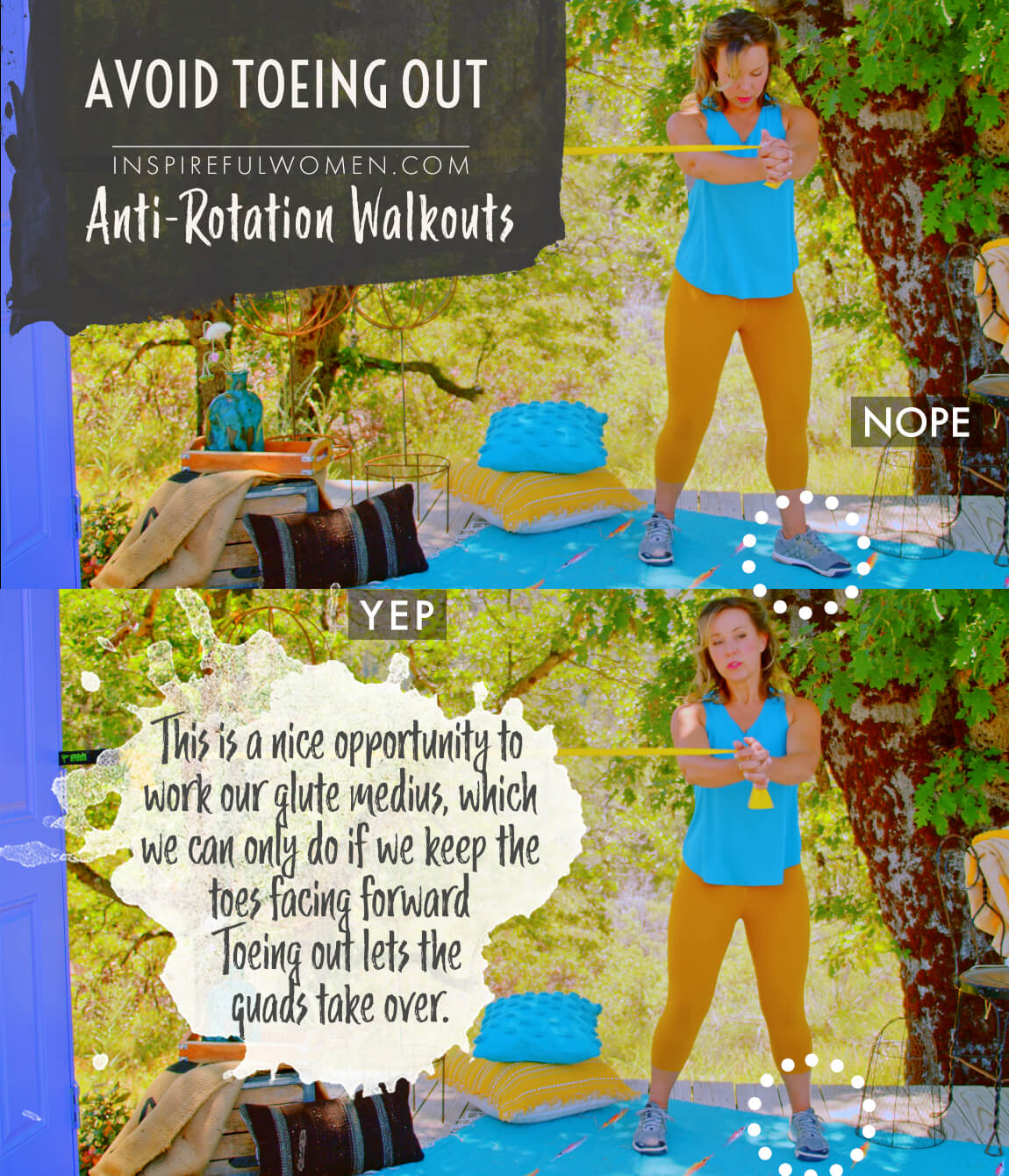
4. Avoid taking too big of a step
AVOID: Avoid taking too big of a step.
WHY NOT?
- This will make it more challenging to control the movement and stability and will not increase the benefits of the exercise.
WHAT TO DO:
- Take a small step - about 10-12 inches, maintain good balance and control.
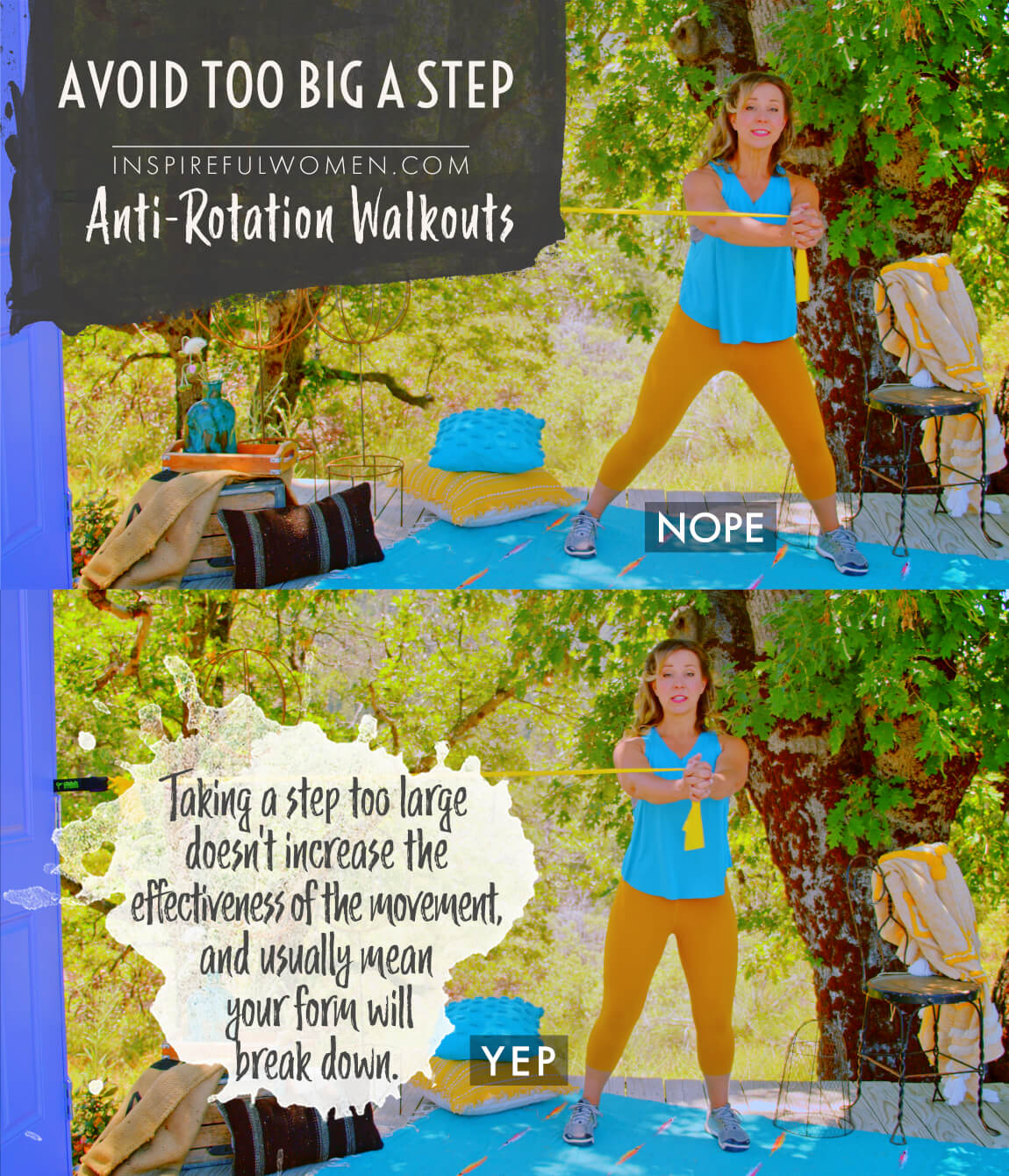
5. Avoid dragging leg
AVOID: Avoid dragging the following foot/foot of lifting leg.
WHY NOT?
- In our efforts to glide sideways and not bob up and down, we might start dragging the foot of the following leg.
WHAT TO DO:
- Be sure to actually lift the following leg and STEP not drag the foot next to the other foot.

WHAT WE'RE DOING TODAY
WHAT & WHY
BENEFITS OF TRAINING THE CORE muscles
WHAT
By performing this standing obliques exercise, you're training your core to resist rotation, promoting better posture, enhanced stability, and reduced risk of injuries.
Anti-rotation core walkouts require you to hold your torso still against the increasing pull of a resistance band. The band is held in your arms which are stretched out in front of you. The resistance of the band is trying to rotate the upper body. The core muscles have to work to hold the torso facing forward. The further you step out the more the band will pull and the harder the muscles will have to work. Not only is this a nice core workout, but the hip muscles have to work hard also.
This is a full-body workout. This exercise works many of the muscles in the legs, trunk, and arms. As you side-step out and back the muscles need to work to hold the feet, ankles, knees, hips, pelvis, spine, shoulders, elbows, and wrists stable and aligned against the increasing rotational force. Using a band makes it easy to adjust how difficult this exercise is. Remember that this is a core exercise, not a leg or arm exercise. Use a band that lets you feel your core muscles work as you sidestep out and back. This exercise is easily adjusted to accommodate varying levels of balance, stability, control, and strength.
WHY BOTHER DOING IT?
WHY
WHY DO WE EVEN CARE?
This exercise is a simple movement - just side-stepping out and back. The focus is on keeping your spine neutral and very still as your legs move. This is a valuable skill to learn. First and foremost the exercise trains good posture while you are moving. Standing or walking with poor postural alignment can cause muscle imbalances and soft tissue injury over time.
Most back injuries happen as a result of bending and twisting at the same time, especially under load - meaning while you are lifting or carrying something. This position, the spine bent (flexion) forward and rotated, is a position where the discs and joints of the spine are in a weakened position making them more prone to injury. Learning how to move correctly and strengthening the muscles of the core will help to protect the back from injury.
This exercise targets the internal and external obliques. These are muscles that wrap around the sides of the torso. They can rotate and bend the spine, and they are very important for maintaining upright posture and supporting the spine. The external obliques are broad muscles that start on the bottom ribs and run diagonally down to attach to the pelvis. The internal obliques lie under the external obliques and run diagonally in the opposite direction.
Another benefit of this exercise is that it trains balance, leg strength, and stability. The hip abductors are muscles that are important for holding the pelvis in a good position during standing and all upright activities, are worked when you step out, pulling the body out against the increasing resistance from the band. They also work to decelerate (eccentric contractions) the movement of the body as the band pulls you back in. The muscles that stabilize and protect the knee and ankle will be working to maintain proper alignment of the leg and foot.
EVERYDAY LIFE
EVERYDAY LIFE &
MUSCLE FUNCTION
HOW WE USE OUR Obliques IN EVERYDAY LIFE
1. THE OBLIQUES ARE USED TO MAINTAIN UPRIGHT POSTURE
- Standing
- Sitting
- Kneeling
- Walking
- Running
2. PROTECT THE SPINE DURING LIFTING AND ROTATIONAL ACTIVITIES
- Shoveling snow
- Raking
- Vacuuming
- Taking dishes out of a dishwasher or clothes out of the dryer
3. THE OBLIQUES STABILIZE THE SPINE AND PREVENT COMPRESSION ON ONE SIDE WHEN HOLDING OBJECTS ON ONE SIDE
- Holding a child on one hip
- Carrying a suitcase or grocery bag on one side
SCIENCY STUFF
ALLLL MUSCLES & WHEN
ALL MUSCLES WORKING & WHEN DURING THE One Hand Anti-Rotation Walkout
The shoulder blades are pulled down (depression) and back (retraction) by the rhomboids, trapezius, latissimus, serratus anterior, pectoralis - initially this effort is minimal but it increases as you walk out.
Using the hand furthest from the anchor: To prevent being pulled across the chest (horizontal adduction) - the posterior deltoid, lateral deltoid, teres major, teres minor, infraspinatus will work isometrically to hold the arm in place; the mid traps and rhomboids will become more active to hold the shoulder back (retraction).
Using the hand closest to the anchor: The anterior deltoids and biceps work isometrically to hold the arms up in front of the body. The pectoralis major and coracobrachialis muscles work isometrically to prevent the band from pulling the arm out into horizontal abduction. The scapular retractors will be assisted by the band, so they will not be as active.
Working arm: The elbows and wrists are straight and stabilized by the muscles that cross the wrist and elbow joints. The internal and external obliques are working to prevent rotation of the torso.
The legs begin with a side-step - the leg furthest from the band will lift from the floor to step out. When the leg furthest from the band lifts up to a side step away from the band, the unweighted side of the body will be pulled into rotation towards the band anchor. The weight-bearing hip will need to stabilize against a relative internal rotation and adduction - the hip external rotators (obturator internus and externus, gluteus maximus, piriformis, superior and inferior gemellus, and quadratus femoris) and abductors (gluteus medius, minimis) will work with a combination of concentric, eccentric and isometric contractions to stabilize. As soon as one leg is picked up the muscles of the other leg will need to work to hold the ankle, knee, and hip in alignment.
All of the core stabilizers will be working, at some level, to hold the hips and shoulders squared: obliques, quadratus lumborum, transverse abdominis, erector spinae, rectus abdominis, multifidi, iliopsoas, latissimus dorsi. The more resistance used (further from the band or heavier band) the more muscles will be recruited.
The leg that is furthest from the anchor is planted down to complete the step. The hip adductors contract concentrically to pull the body over it as the weight is shifted from the leg closest to the anchor. The leg closest to the anchor lifts up, and the leg furthest from the anchor is pulled into abduction and external rotation. The adductors (adductor magnus, brevis, longus, gracilis, pectineus, and quadratus femoris), and internal rotators (tensor fascia latae, gluteus minimus) will work to hold the hip in neutral.
When the leg is weight-bearing, most of the muscles that cross the hip joint will be active all at once to stabilize the hip, especially as you step out further - your body will be pulled towards the band anchor.
When you are out as far as you are able to go and you lift the leg closest to the anchor to begin the return, the leg furthest from the anchor will work very hard with a combination of eccentric, concentric, and isometric contractions of the hip muscles to stabilize the body. When the leg closest to the anchor is set down and the other leg is lifted, the weight-bearing leg (closest to the anchor, is pulled into internal rotation and adduction. The hip external rotators and abductors will work eccentrically to resist the pull.
PIN IT FOR LATER!
